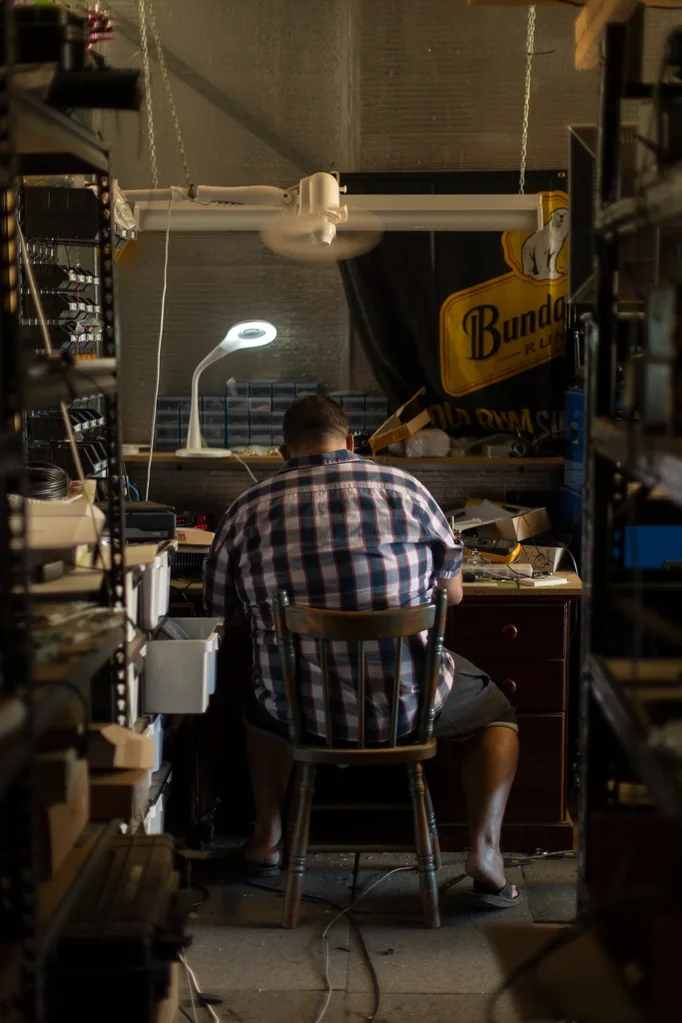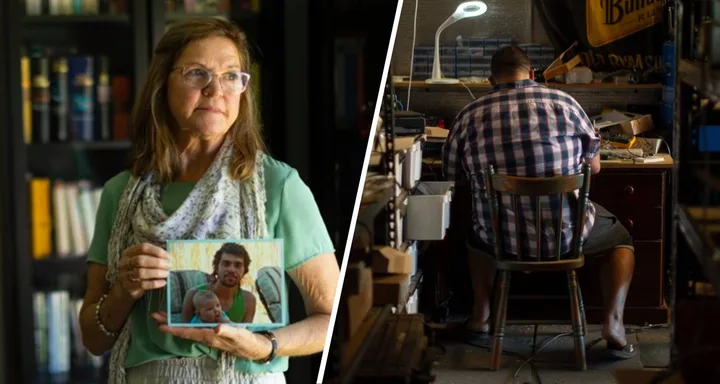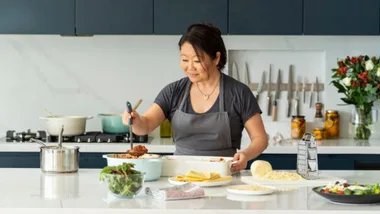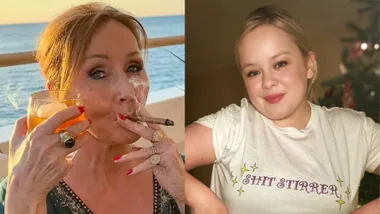As the rates of meth addiction sweep Australia at an alarming pace, access to rehabilitation facilities has become increasingly challenging – particularly for addicts in isolated rural towns. In the face of rising deaths, Ginger Gorman shines a light on one Australian community that has bravely fought back.
Patsy feels lucky that the neat two-bedroom unit she bought in 2017 is surrounded by a courtyard of fragrant rose bushes. “That way I can pick them whenever I like, and take them to the cemetery,” she says. We drive slowly down her street towards the graveyard, take a few turns then make our way past the house where her beloved youngest son, Lenny, died by drug-induced suicide in 2017. He was 25 years old.
Patsy, 62, gestures towards the enamel photograph set into Lenny’s shining black granite headstone: “That was taken on our last Christmas together and he looks wonderful. He’s got piercing eyes.” She kneels down, staring into her son’s face. “I wanted to do some of this interview at Lenny’s grave because – the hard truth is – if you can’t survive your addiction, this is where you end up. This is where your family will have to come to see you.”
The eucalypts are undulating in the hot breeze. The wind moves through the grass in slow waves and birds are soft but persistent in their calls. “As beautiful as this cemetery is, it’s not where I want Lenny to be,” Patsy says.
She lays her home-grown roses beside the grave, alongside other trinkets and mementos: a ceramic angel, a cigarette, some potted succulent plants, items that mark Lenny’s Indigenous ancestry. The flowers are already wilting in the heat and giving off perfume. Pointing at a warming tin of alcohol, she remarks: “Today, someone’s left him a can of bourbon and Coke. It’s comforting to me to know that people haven’t forgotten him, that they come and visit him from time to time. It’s lovely.”
The local government area of Mildura has a suicide rate twice that of the Victorian state average, according to Australian Institute of Health and Welfare statistics.
Similarly, the most recent available data from the non-profit addiction research and education centre Turning Point shows that episodes of care for alcohol and illicit drugs occur at more than twice the state-wide rate.
Megan Button is a long-time mental health drug and alcohol clinician with Sunraysia Community Health Services (SCHS), where clients are offered a suite of outpatient programs. In her first email to me, Megan talks of her passion for the “proud and wonderful” Mildura community and the work she does – despite the ever-increasing number of clients needing assistance.

She mentions the pressures of Covid lockdowns on Victorians and the consequent mental-health impacts. “In terms of our referrals for alcohol and drug services, these have certainly increased in the past couple of months [March to May] … There’s also been a high demand of referrals for our Opiate Replacement Treatment Program [which] … is currently at capacity and can’t keep up with demand.
“Unfortunately, we do not have the access to facilities as you would in the cities,” Megan adds. “We also do not have the same programs, such as Narcotics Anonymous, or peer groups.”
For Megan, the missing link for locals struggling with addiction is a residential rehabilitation service in the community – a place where people suffering addiction can withdraw safely in a supervised facility over weeks or months.
Mildura is believed to be the Victorian regional centre most isolated from a residential rehab. The nearest facility is 4.5 hours away by car in the city of Bendigo. Mildura has no passenger train, and plane travel to Melbourne is expensive (and therefore out of reach for many who are suffering addictions).
And Mildura is not alone. Despite research showing that in the past decade the rate of drug-induced deaths has increased at a faster rate in regional and remote areas than in major cities, many regional centres lack access to residential drug and alcohol rehab facilities. These include towns such as Albany and Esperance in Western Australia and NSW’s Broken Hill – which is 7.5 hours from the nearest residential rehab at Brewarrina. Like Mildura, local communities are fighting for services.
Patsy explains her unwell son was impacted by the under-resourcing of the area’s local services. “I know that’s not their fault, but if you’ve got a child … who’s suffering withdrawal and they’re told at 10 o’clock in the morning, ‘You’re not going to get seen until 2pm,’ what do you do with them? How do you keep them calm? How do you stay calm yourself in those hours where you’re waiting to get help?”
Reflecting with both joy and pain of her late son’s life, Patsy says Lenny was “adorable” as a little boy. “He loved his big brothers. He loved animals. He loved Batman. And as he grew, those personality traits just grew with him. He didn’t really change over the years in that respect. Lenny had a good upbringing. He had a beautiful family that loved him. And beautiful friends.”
Despite these qualities, Lenny struggled in the last years of his life. He had a different father to Patsy’s two older boys and rarely saw him. “I think Lenny’s main problem was not having a connection with his father, Ricky,” Patsy says. “It was a connection he wished he had, but unfortunately his father suffered from addictions and was very violent. That’s why the relationship I had with him was short.”
Around Year 10, things started to get tougher for Lenny. According to Patsy, he “was academically brilliant, but his behaviour started changing. He was starting to get in trouble at school. His temper was getting a bit short.”
Patsy is a shift worker and because she often worked late or early shifts, sometimes back-to-back, it made her son hard to keep track of. “In the later years, he told me he used to sneak out the window,” she says. “He’d be gone. He’d sneak in just before I’d get home from work. Once I’d gone to bed, he’d be back out the window again.” Soon, things got worse. Lenny got kicked out of one school and left another. He couldn’t hold down a job and then his father died in 2013. “Any hope he had of a connection with his father was gone then,” says Patsy. “He wasn’t coming home very often.”

One incident sticks in Patsy’s mind. Lenny had called her asking to be picked up. “We were driving back home, and I said, ‘Lenny, can you be honest with me? Are you on drugs? If you’re on drugs, I need to know what you’re taking’.” Patsy’s voice waivers and tears roll down her face. “And that’s the first time he told me that he used a syringe and shot up. And the hurt I felt that he’d actually done that to his body. How could he hurt himself like that? How could he do that?”
As Lenny descended further into addiction, Patsy would find meth pipes and syringes in his room. He’d also steal the Panadeine Forte tablets she took for migraines. “He didn’t worry about hiding things,” she says.
On the day Lenny’s body was found, Patsy was working. As fate would have it, the house where he died – notoriously known in the neighbourhood as a drug den – was just over the back fence. One of her colleagues saw his body and ran out with a defibrillator. But it was far too late to save him. Without knowing Lenny’s identity, the fellow staff member told Patsy there had been a suicide.
Patsy recounts this terrible moment as if it happened yesterday: “And I said, ‘Well, at least some drug addict is finally at peace,’ because I knew in that house, they associate with drugs. Then I said, ‘How could I think like that? Imagine the poor parents or parent.’ The minute I said ‘parent’, I had this overwhelming feeling that it was Lenny.”
She went to see his body as it was lying on the cold ground but couldn’t bear to stay long. “It was just so horrible,” she says. “I knew there was no life left in his body, but I just wanted him in a safer, cleaner place than where he was.”
Sunraysia locals know all too well that drug and alcohol dependence is a problem in their community and have been campaigning for a decade to get a residential drug and alcohol facility. Former Mildura mayor Simon Clemence – previously a police inspector whose son, Geoffrey, died from alcohol-related suicide in 2019 – was a major force behind putting together a business case for a proposed facility during his two terms in office.
With local services offered in Mildura by SCHS and Mallee District Aboriginal Services already stretched, it was clear the community needs additional help. According to Dr Nicole Lee from the National Drug Research Institute at Curtin University, “There’s no one size fits all,” she says. “Some people need residential treatment and some need non-residential treatment. Residential rehabilitation is the last-line treatment option for people with more severe problems, who have tried other options unsuccessfully, or who have a home life that is not helpful for making changes, or who need some time out to be able to focus on their own recovery.”
READ THIS: Meet The Women Fighting Australia’s Ice Crisis
An analysis done for the Victorian rehabilitation service Odyssey House shows that each person who receives residential treatment generates an average economic benefit for the rest of the community of more than $1 million over their lifetime. Not only are individuals more productive, but there is decreased social security spending, crime and premature death.
With evidence in hand, a consortia of local agencies knocked on the doors of the state and federal governments for funding again and again. The requests were not answered. Simon Clemence declined an interview with marie claire, but has been previously quoted many times in the press discussing his frustrations with the continually stalling process.
To an outsider, it’s puzzling why a community so clearly in need has had to spend years trying to secure funding. Not so for Independent MP for Mildura, Ali Cupper. She notes that federally, the seat of Mallee has always been a safe Country/Nationals seat: “So what that means is, when it comes to determining budget priorities in a political environment, no-one’s ever fighting over us … because they don’t need to, because the result is a foregone conclusion every time.”
Until Ali was elected at the state election in 2018, the Victorian seat of Mildura was also considered a safe National seat. Therefore, the federal situation was replicated on a state level.
Before becoming an MP, Ali worked in child protection. While noting all communities can be impacted by alcohol and drug dependence, she describes the problem in her region as “a scourge”. Alongside Indigenous elders Aunty Jemmes Handy and Patsy Doolan, Ali has been fighting tooth and nail for a residential withdrawal and rehabilitation centre. “It’s costing lives,” she says. “It’s causing tragedy across our region. And we don’t have the resources we need to deal with it.”
The lack of local residential services is exactly why Robert*, now 42, had to travel across the state for treatment. These days he’s a successful Mildura businessman and a happily married father of two kids. But 15 years ago, he was in the grip of a terrible heroin addiction. The disease had such a hold on him, Robert and his then-girlfriend, who was also an addict, would do anything to get their next fix.
“We were lying to our families, stealing from them, taking money out of wallets and purses, just doing anything we had to be able to score,” he recalls. “My biggest regret [is that] I even stole from my grandmother. The day I found her dead, I took her last $50 out of her purse – even before I picked up the phone to call Dad. I’m ashamed of it. It’s not something I could ever imagine myself doing now.”

Robert is convinced he only survived his addiction due to his 14-month stint at Odyssey House’s residential drug and alcohol facility in Melbourne. “During that time,” he says, “I reconciled with my family. I learned a lot about myself. I learned I suffer from anxiety, and I learned the technique of just sitting with those feelings when you’re having an anxiety or panic attack, knowing it will pass, and not feeling you have to run away and numb the pain with a drug.”
After getting on his feet he moved to Bendigo and then Mildura, where he met his wife and he’s been clean since.
During the process of writing this article, the tables take a dramatic turn. In the 2022/23 Victorian budget in May, the government announces $36 million for a 30-bed residential detox and rehab centre in Mildura. Locals are jubilant about their hard-fought win. “It’s just a dream come true for families in our region,” says Ali. “We desperately need this. It’s going to save lives. And as an MP, and also a Mallee girl, it makes me extremely proud.”
Robert is similarly delighted at the news a rehabilitation facility has finally been funded. “No-one could be happier than I am, especially knowing firsthand that residential rehab works. I’m a graduate, after all.”
Lenny also did stints at Odyssey House in Melbourne and in Molyullah (sometimes it takes addicts many stints in rehab to forge a path to recovery). But like so many before Lenny, the distance from these locations to Mildura – nearly six hours by car – made it hard for his Mallee family to support him. “It was too far to visit on the weekend for me and his brothers,” Patsy says. “And yet keeping connected with family was so important to him. I believe that if there was somewhere closer, that would have made his rehab so much better.”
I phone Patsy on the day Mildura locals learn they’ll get their hard-won rehab facility. “It’s so amazing,” she says, her voice cracking with emotion. “I’m so proud of what we’ve achieved. It’s a game changer for everyone in Mildura. But it’s also bittersweet, because if it were five years earlier, Lenny might still be here.”
This story was reported as a result of journalist Ginger Gorman’s touring collaborative arts-documentary project “On Thin Ice,” which tells the real-life stories of methamphetamine addiction. It’s an initiative of the Tuggeranong Arts Centre in Canberra, supported by the ACT Government and Visions of Australia Touring Fund.
If this story has raised concerns for you, please contact Lifeline on 13 11 14 or Beyond Blue on 1300 22 4636.
This story originally appeared in the July issue of marie claire Australia.










